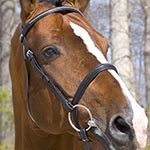
by Sharon Soileau 12-23-2008 02:00 AM
With all horses having individual tastes and temperaments, there are as many types of equipment used as there are horses.
The most popular type of equipment are blinkers--a hood that fits over a horse's head with holes for the ears and extensions of various lengths on the sides of the eyes, then fastens under the jaw. Blinkers are used for a variety of reasons and have been in use on horses since the 1800's.

French cup blinkers have an extension of about two inches and keep the horse from seeing behind him. Many horses watch their rider's movements instead of focusing on the task at hand. French cups will allow the horse to see everything but his rider.
Full cups curve around from behind the eye and are about three inches long. This type of blinker is best used on horses who have a habit of looking around while running. They will only be able to see what is ahead of them.
Extension blinkers are for horses who have a habit of drifting to one side or the other. Usually an extension will be used only on one side--whatever side the horse drifts to. This cup, which completely obscures the horse's peripheral vision, allows the horse to see only what is directly in front of him.
The bit, which is the metal piece placed in a horse's mouth for control, comes in many flavors as well. The most popular is the Dexter ring bit. The mouthpiece on this bit is jointed in the middle with a thin ring that runs through the mouth and around under the chin. Most riders prefer this bit as they believe it provides the most control on their mounts.
Simple snaffle bits are also very popular. These are lightweight with a jointed mouthpiece that is covered in rubber for tender mouth horses, stainless steel for long wear, or copper-plated, which keeps a horse's mouth moist.
Other bits that are used are the Citation, Haughton, Springsteen, screw bit, and an assortment of "run-out" bits. All of these are used for animals that are very hard to control during the race.
Cavesons, or nose-bands are common place. This piece of equipment circles the head about halfway between the eyes and mouth. It is attached to a longer piece of material, either leather or nylon, which runs up both sides of the head and behind the ears to keep it in place. Cavesons are used to keep the mouth closed during the race.

Figure-eight nosebands are often used in place of a regular noseband. Curlin raced in a figure-eight, so named because it forms the figure of an eight when in place. It encircles the head similar to a caveson, but criss-crosses over the bridge of the nose and loops under the chin just in front of the bit.
Running bandages are commonly used for numerous reasons. Bandages or vet-wraps, are a single-use waterproof elastic material that sticks only to itself. Wraps on the hind legs are typically referred to as run-down bandages. They provide protection to the underside of the horse's ankles during a race. Many horses "run down", meaning that the bottoms of their ankles are scalded by the running surface. Front bandages are also used to prevent running down, where a horse sometimes strikes his front legs with a hind hoof. It also provides additional support to the ankles and tendons since most of the weight is carried by the front legs while running.

There are several other pieces of equipment that are used, such as shadow rolls, nasal strips, channels, chamois, and breast plates, to name a few. It is up to the trainer to figure out what works best for each of the horses in his/her stable.
Published 12-23-2008 © 2024 Access Athletes, LLC
Disclaimer:
Access Athletes, LLC owns the exclusive copyright to all information contained within the articles posted on The Real Athlete Blog. All information is for the End User's use only and may not be sold, redistributed, or otherwise used for commercial purposes without the expressed consent of Access Athletes, LLC. The information is an educational aid only and it is not intended as and nor shall it be construed as legal, medical, financial, psychological or other professional advice or treatment for individual situations, conditions, or predicaments. The information provided in The Real Athlete Blog articles shall not constitute an attorney-client, doctor-patient, psychologist-patient relationship or any other professional-client relationship for that matter. The End User shall seek the advice or treatment of his or her own qualified licensed professional(s) and the End User shall not rely on the information contained herein as such. End Users who leave comments on the Blog articles or email the contributors personally shall have no expectation of privilege or confidentiality. Additionally, we strongly recommend that you consult your doctor, nurse, nutritionist or pharmacist before following any of our workout or nutrition regimens to ensure that it is safe and effective for you.
Access Athletes, LLC makes no representation or warranties as to the information, opinions, or other services or data you may access, download or use as a result of accessing The Real Athlete Blog. All implied warranties of merchantability and fitness for a particular purpose or use are hereby excluded. Access Athletes, LLC does not assume any responsibility for your use of or reliance on any of the information provided by The Real Athlete Blog.